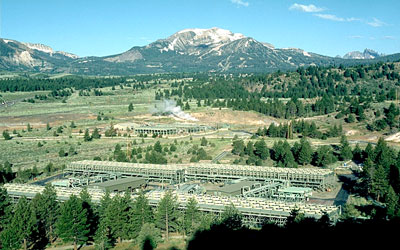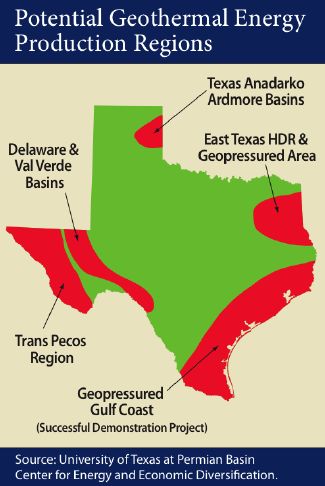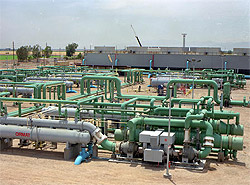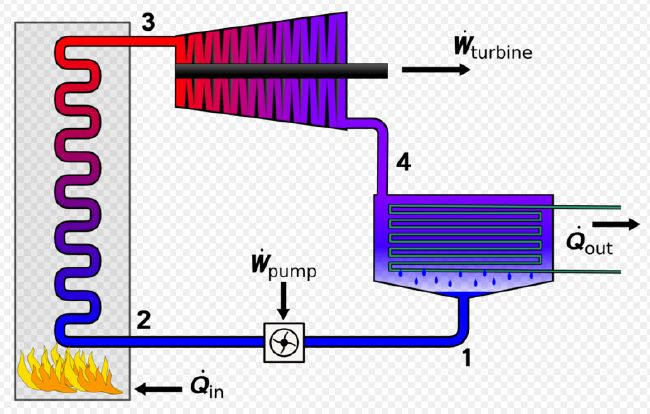Archive for the 'Geothermal' Category
Geothermal 101

Attribution: USGS
George Gorski over at Seeking Alpha has posted a nice entry on geothermal entitled “Geothermal 101” – it’s a very good read and has the added benefit of exploring the geothermal supply chain in addition to developers and operators. It succeeds in giving a baseline education on the types of harvest techniques, the development challenges and benefits, and in the publicly traded companies participating in the industry.
Mr. Gorski, if you read this, there is one major correction to your article: Calpine (of San Jose – not San Diego) operates 19 of the 21 plants at The Geysers. The Northern California Power Association operates the other two. Also, two new developer/operators are working in The Geysers, US Renewables is re-powering a the old DWR Bottle Rock plant and Western GeoPower is re-powering the old PG&E Unit 15 plant. There are many more plants in California in the Mammoth, Coso, and Imperial Valley regions. Otherwise, a very good article and highly recommended.
Links: Geothermal 101 at Seeking Alpha
Geothermal Potential in Texas

Susan Combs, the Texas Comptroller of Public Accounts, has recently released a comprehensive report on energy in the state of Texas. The 33 chapter report is extensive and fact-based, covering virtually every energy source one can think of, fossil-based, renewable, and experimental. It’s really a fantastic bit of research.
Why does Texas care so much about energy? The answer is pretty simple, the average Texan consumes 3x as much energy per capita as the average US citizen and a large segment of Texas GDP is derived from energy related business. Those two facts mean that Texas suffers disproportionately as the price of energy rises but it also means that Texas has a potential advantage since it has a workforce that understands the energy business.
Chapter 21 has to do with the geothermal potential of Texas (see the map at the right) and covers co-generation as a consequence of oil/gas production, enhanced geothermal systems, and geothermal heat pumps. On the co-generation side alone, the report speculates that over 2,000MWe of production may be available. In the 1980s a 1MW co-generation test was run producing over 3,000MWh of power, but it was discontinued due to being non-cost competitive. While there are no active geothermal projects in Texas, recently leases on 11,000 acres have been granted generating over $50,000 in revenue for the state.
Of all the impact geothermal technologies could have in Texas, the most cost effective and most likely implementation is of geothermal heat pumps. A technology that effectively moves heat from the air to the ground and vice-versa. Particularly in the sweltering summer months, a GHP system could serve as a relatively inexpensive way to keep people cool as energy prices rise.
Q1 Strong for Ormat
Pure play geothermal equipment and electricity generator Ormat (ORA) turned in a very strong Q1 earnings result today. The company increased the top line from $62M to $69M Y/Y despite the fact that the product segment revenue fell by 50% in the same period. This was offset by an increase in the generation segment due to greater MWh produced and higher prices being secured for that energy.
Even better for long-term shareholders, costs were controlled tightly and were down $9M overall. But the electricity segment was down $1.1M while net output from the unit increased making it significantly more profitable. Profits for the quarter were $10M after taxes compared to -$5.8M in the same period last year.
No matter how you cut it, this was a stellar quarter for Ormat.
Disclosure: The author holds no position in Ormat.
Heber South enters Commercial Operation

Photo Credit: EERE
Last week Ormat announced that the 10MW Heber plant had been commissioned. This brings total output of the Imperial Valley facility to 92MW and boosts Ormats portfolio to over 400MW for the first time. Ormat is slated to announce first quarter earnings tomorrow (May 6th.)
What’s in a Name?
If you think that this entry will be about literature, you’ll be disappointed. It’s about the noise being generated right now around various thermodynamic cycles where heat is converted to work. Recently we’ve seen an upswell of interest in the Kalina Cycle harvest method and a number of companies have been chartered and funded to produce harvest systems for a variety of heat sources (like Exorka and Kalex.)
But just what is Kalina Cycle? Before we answer that, we need to take a look at basic Rankine Cycle (or sometimes called Carnot Cycle) harvest. It is a 4 stage process by which a working fluid is pressurized, heated to prompt phase change from liquid to gas, expanded through a harvest device (typically a turbine,) and then condensed. The cycle is closed loop in nature and forms the basis for virtually all electricity generation involving heat (geothermal, solar thermal, natural gas, coal, and nuclear – for the US, that’s 90+% of generation.)

Attribution: Andrew Ainsworth
A variation on theme is Organic Rankine Cycle which follows the same process as Rankine Cycle with the principal difference being the composition of the working fluid. In straight RC the working fluid is most often water. In ORC the working fluid tends to be a stable compound with a relatively low boiling point (i.e. isobutane or isopentane.) This is less efficient than RC but can harvest energy from heat sources from 75-150C where RC requires 250C and higher temperatures to function well.
Thus we come to Kalina Cycle, really a variation on ORC (and thus RC.) It was proposed by Alexander Kalina about 20 years ago. KC follows the same process as RC, but again changes the composition of the working fluid from a single stable compound with a low boiling point to a two part working fluid (most often ammonia/water mixture) which can, under certain circumstances, increase the efficiency of ORC harvest of relatively low temperature resources.
Of the 3 related conversion cycles, RC and ORC are in wide use today. Kalina Cycle is still gaining steam, so to speak. 2 comments








